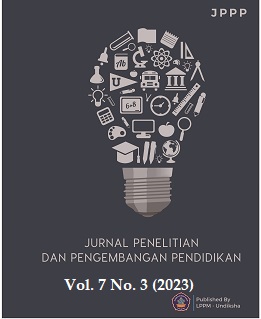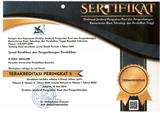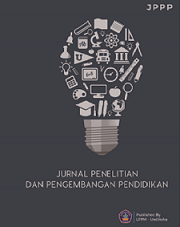Socio-Scientific Issues Using Two-Tier Instruments Based on Literacy Analysis
DOI:
https://doi.org/10.23887/jppp.v7i3.63763Keywords:
Chemical literacy, two tier multiple choice, Socio Scientific Issues, Acid-BaseAbstract
Chemical literacy is important for someone to have to understand scientific problems that occur in everyday life so that they can choose wise decisions in solving them. The objectives to be achieved in this study are to analyze the students' chemical literacy skills on acid-base material using a two-tier multiple-choice instrument SSI based. The research design used is a descriptive qualitative method. The sample in this study was taken or selected using a purposive sampling technique. Data collection techniques are used by researchers in the form of tests and interviews. The steps taken to analyze the data are data collection, data reduction, data presentation, and drawing conclusions. The results of this study indicate that 1. The results of the students' chemical literacy test on acid-base material showed that as many as 15% of students were in the high category, 62% of the students were in the medium category, and 23% of the students were in a low category. 2. Students' chemical literacy was sufficient in the aspect of content (79%), context (70%), HOTS (69%), and attitudes (66%). The sub-indicator that students mastered the most in context indicators was analyzing the strategies and benefits of chemical applications. In the HOTS indicator, the students' most dominant skills are asking questions and seeking information on chemical issues. The attitude indicator shows the lowest achievement among other indicators due to the lack of student interest in issues related to chemistry.
References
Abosalem, Y. (2015). Assessment techniques and students’ higher-order thinking skills. ICSIT 2018 - 9th International Conference on Society and Information Technologies, Proceedings, 4(1), 61–66. https://doi.org/10.11648/j.ijsedu.20160401.11. DOI: https://doi.org/10.11648/j.ijsedu.20160401.11
Ad’hiya, E., & Laksono, E. W. (2020). Development and validation of an integrated assessment instrument to assess students’ analytical thinking skills in chemical literacy. International Journal of Instruction, 11(4), 241–256. https://doi.org/10.12973/iji.2018.11416a. DOI: https://doi.org/10.12973/iji.2018.11416a
Ahdhianto, E., Marsigit, Haryanto, & Nurfauzi, Y. (2020). Improving Fifth-Grade Students’ Mathematical Problem-solving and Critical Thinking Skills Using Problem-Based Learning. Universal Journal of Educational Research, 8(5), 2012–2021. https://doi.org/10.13189/ujer.2020.080539. DOI: https://doi.org/10.13189/ujer.2020.080539
Al-Gindy, A., Felix, C., Ahmed, A., Matoug, A., & Alkhidir, M. (2020). Virtual reality: Development of an integrated learning environment for education. International Journal of Information and Education Technology, 10(3), 171–175. https://doi.org/10.18178/ijiet.2020.10.3.1358. DOI: https://doi.org/10.18178/ijiet.2020.10.3.1358
Ambarita, S. M., Asri, L., Agustina, A., Octavianty, D., & Zulkardi. (2018). Mathematical Modeling Skills on Solving PISA Problems. Journal of Physics: Conference Series, 1097(1). https://doi.org/10.1088/1742-6596/1097/1/012115. DOI: https://doi.org/10.1088/1742-6596/1097/1/012115
Anagnostopoulou, K., Hatzinikita, V., & Christidou, V. (2012). PISA and biology school textbooks: The role of visual material. Procedia-Social and Behavioral Sciences, 46, 1839–1845. https://doi.org/10.1016/j.sbspro.2012.05.389. DOI: https://doi.org/10.1016/j.sbspro.2012.05.389
Anggraeni, A.Y., Wardani, S., & Hidayat, A, N, 2020. (2020). Profil Peningkatan Kemampuan Literasi Kimia Siswa Melalui Pembelajaran Inkuiri Terbimbing Berbasis Kontekstual. Jurnal Inovasi Pendidikan Kimia, 14(1), 2512–2523. https://doi.org/10.15294/jipk.v14i1..18979.
Anggraeni, P., & Akbar, A. (2018). Kesesuaian rencana pelaksanaan pembelajaran dan proses pembelajaran. Jurnal Pesona Dasar, 6(2), 55–65. https://doi.org/10.24815/pear.v6i2.12197. DOI: https://doi.org/10.24815/pear.v6i2.12197
Aprilliyah. (2014). Pengembangan Media Pembelajaran Modul Interaktif Pada Materi Jurnal Khusus Kelas X Akuntansi di SMK Negeri Mojoagung. Jurnal Khusus, 2(2), 1–7. https://jurnalmahasiswa.unesa.ac.id/index.php/35/article/view/9412.
Arikunto, S. (2007). Prosedure Penelitian Suatu Pendekatan Praktik. PT. Rineka Cipta.
Aufa, M. N., Rusmansyah, R., Hasbie, M., Jaidie, A., & Yunita, A. (2021). The Effect of Using e-module Model Problem Based Learning (PBL) Based on Wetland Environment on Critical Thinking Skills and Environmental Care Attitudes. Jurnal Penelitian Pendidikan IPA, 7(3), 401–407. https://doi.org/10.29303/jppipa.v7i3.732. DOI: https://doi.org/10.29303/jppipa.v7i3.732
Barke, H. D., Hazari, A., & Yitbarek, S. (2008). Misconceptions in chemistry: Addressing perceptions in chemical education. In Misconceptions in Chemistry: Addressing Perceptions in Chemical Education. Springer Berlin Heidelberg. https://doi.org/10.1007/978-3-540-70989-3. DOI: https://doi.org/10.1007/978-3-540-70989-3
Demirbaş, İ., & Şahin, A. (2022). The effect of digital stories on primary school students’ listening comprehension skills. Participatory Educational Research (PER), 9(6), 380–397. https://doi.org/10.17275/per.22.144.9.6. DOI: https://doi.org/10.17275/per.22.144.9.6
Dewi, C. A., Khery, Y., & Erna, M. (2019). An ethnoscience study in chemistry learning to develop scientific literacy. Jurnal Pendidikan IPA Indonesia, 8(2), 279–287. https://doi.org/10.15294/jpii.v8i2.19261. DOI: https://doi.org/10.15294/jpii.v8i2.19261
Dewi, R. K., Wardani, S., Wijayati, N., & Sumarni, W. (2019). Demand of ICT-based chemistry learning media in the disruptive era. International Journal of Evaluation and Research in Education, 9(2), 265–270. https://doi.org/10.11591/ijere.v8i2.17107. DOI: https://doi.org/10.11591/ijere.v8i2.17107
Dou, R., Brewe, E., Potvin, G., Zwolak, J. P., & Hazari, Z. (2018). Understanding the development of interest and self-efficacy in active-learning undergraduate physics courses. International Journal of Science Education, 40(13), 1587–1605. https://doi.org/10.1080/09500693.2018.1488088. DOI: https://doi.org/10.1080/09500693.2018.1488088
Goeltz, J. C., & Cuevas, L. A. (2021). Guided inquiry activity for teaching titration through total titratable Acidity in a general chemistry laboratory course. Journal of Chemical Education, 98(3), 882–887. https://doi.org/10.1021/acs.jchemed.0c01198. DOI: https://doi.org/10.1021/acs.jchemed.0c01198
Habig, S. (2020). Who can benefit from augmented reality in chemistry? Sex differences in solving stereochemistry problems using augmented reality. British Journal of Educational Technology, 51(3), 629–644. https://doi.org/10.1111/bjet.12891. DOI: https://doi.org/10.1111/bjet.12891
Hanik, N. R., Harsono, S., & Nugroho, A. A. (2018). Penerapan Pendekatan Contextual Teaching and Learning dengan Metode Observasi untuk Meningkatkan Hasil Belajar pada Matakuliah Ekologi Dasar. Jurnal Pendidikan Matematika Dan IPA, 9(2), 127–138. https://doi.org/10.26418/jpmipa.v9i2.26772. DOI: https://doi.org/10.26418/jpmipa.v9i2.26772
Herkusumo, A. P. (2011). Penyetaraan (Equating) Ujian Akhir Sekolah Berstandar Nasional (UASBN) dengan Teori Tes Klasik. Jurnal Pendidikan Dan Kebudayaan, 17(4), 455. https://doi.org/10.24832/jpnk.v17i4.41. DOI: https://doi.org/10.24832/jpnk.v17i4.41
Hidayah, I. R., Kusmayadi, T. A., & Fitriana, L. (2021). Minimum Competency Assessment (AKM): An Effort To Photograph Numeracy. Journal of Mathematics and Mathematics Education, 11(1), 14–20. https://doi.org/10.20961/jmme.v11i1.52742. DOI: https://doi.org/10.20961/jmme.v11i1.52742
Hong, L. Y., & Talib, C. A. (2018). Scientific Argumentation in Chemistry Education: Implications and Suggestions. Asian Social Science, 14(11), 16. https://doi.org/10.5539/ass.v14n11p16. DOI: https://doi.org/10.5539/ass.v14n11p16
Irwansyah, F. S., Asyiah, E. N., & Farida, I. (2019). Augmented reality-based media on molecular hybridization concepts learning. Tadris: Jurnal Keguruan Dan Ilmu Tarbiyah, 4(2), 227–236. https://doi.org/10.24042/tadris.v4i2.5239. DOI: https://doi.org/10.24042/tadris.v4i2.5239
Iswara, H. S., Ahmadi, F., & Ary, D. Da. (2022). Numeracy Literacy Skills of Elementary School Students through Ethnomathematics-Based Problem Solving. Interdisciplinary Social Studies, 2(2), 1604–1616. https://doi.org/10.55324/iss.v2i2.316. DOI: https://doi.org/10.55324/iss.v2i2.316
Kamarudin, & Djafri, N. (2023). Urgensi Pendidikan Karakter pada Era Society 5.0. Jurnal Ilmiah Multidisiplin, 2(1), 17–23. https://jurnal.aksarakawanua.com/index.php/jakm/article/view/42.
Kamin, Y., Chinedu, C. ., & Olabiyi, O. . (2015). Strategies for Improving Higher Order Thinking Skills in Teaching and Learning of Design and Technology Education. Journal of Technical Education and Training, 7(2), 35–43. https://publisher.uthm.edu.my/ojs/index.php/JTET/article/view/1081.
Kinslow, A. T., Sadler, T. D., & Nguyen, H. T. (2018). Socio-scientific reasoning and environmental literacy in a field-based ecology class. Environmental Education Research, 388–410. https://doi.org/10.1080/13504622.2018.1442418. DOI: https://doi.org/10.1080/13504622.2018.1442418
Krejci, S. E., Ramroop-Butts, S., Torres, H. N., & Isokpehi, R. D. (2020). Visual literacy intervention for improving undergraduate student critical thinking of global sustainability issues. Sustainability (Switzerland), 12(23), 1–19. https://doi.org/10.3390/su122310209. DOI: https://doi.org/10.3390/su122310209
Linda, R., Herdini, H., S, I. S., & Putra, T. P. (2018). Interactive E-Module Development through Chemistry Magazine on Kvisoft Flipbook Maker Application for Chemistry Learning in Second Semester at Second Grade Senior High School. Journal of Science Learning, 2(1), 21. https://doi.org/10.17509/jsl.v2i1.12933. DOI: https://doi.org/10.17509/jsl.v2i1.12933
Marmoah, S., & Poerwanti, Suharno, J. I. S. (2022). Literacy culture management of elementary school in Indonesia. Heliyon, 8(4), e09315. https://doi.org/10.1016/j.heliyon.2022.e09315. DOI: https://doi.org/10.1016/j.heliyon.2022.e09315
Maruti, E. S. (2022). Ketahanan Literasi Anak-Anak di Masa Pandemi melalui Aplikasi Let’s Read (Children’s Literacy Resilience in a Pandemic Period Through the Let’s Read Application. Indonesian Language Education and Literature, 7(2), 247. https://doi.org/10.24235/ileal.v7i2.9298. DOI: https://doi.org/10.24235/ileal.v7i2.9298
Muhali, M. (2019). Pembelajaran Inovatif Abad Ke-21. Jurnal Penelitian Dan Pengkajian Ilmu Pendidikan: E-Saintika, 3(2), 25–50. https://doi.org/10.36312/e-saintika.v3i2.126. DOI: https://doi.org/10.36312/e-saintika.v3i2.126
Mutakinati, L., Anwari, I., & Yoshisuke, K. (2018). Analysis of students’ critical thinking skill of middle school through stem education project-based learning. Jurnal Pendidikan IPA Indonesia, 7(1), 54–65. https://doi.org/10.15294/jpii.v7i1.10495. DOI: https://doi.org/10.15294/jpii.v7i1.10495
Nardo, J. E., Chapman, N. C., Shi, E. Y., Wieman, C., & Salehi, S. (2022). Perspectives on Active Learning: Challenges for Equitable Active Learning Implementation. Journal of Chemical Education, 99(4), 1691–1699. https://doi.org/10.1021/acs.jchemed.1c01233. DOI: https://doi.org/10.1021/acs.jchemed.1c01233
Nugraha, V. D., Muntholib, M., Joharmawan, R., Parlan, P., Yahmin, Y., & Su’Aidy, M. (2020). The development of the acid-base chemistry test oriented to higher order thinking skills for 11th grade students. AIP Conference Proceedings, 2215(April). https://doi.org/10.1063/5.0000546 DOI: https://doi.org/10.1063/5.0000546
Purnamasari, D., Ashadi, & Utomo, S. B. (2020). Analysis of STEM-PBL based e-module needs to improve students’ critical-thinking skills. Journal of Physics: Conference Series, 1511(1). https://doi.org/10.1088/1742-6596/1511/1/012096. DOI: https://doi.org/10.1088/1742-6596/1511/1/012096
Radovanović, D., Hogan, B., & Lalić, D. (2015). Overcoming digital divides in higher education: Digital literacy beyond Facebook. New Media and Society, 17(10), 1733–1749. https://doi.org/10.1177/1461444815588323. DOI: https://doi.org/10.1177/1461444815588323
Rahmawati, Z. D. (2020). Penggunaan Media Gadget Dalam Aktivitas Belajar Dan Pengaruhnya Terhadap Perilaku Anak. TA’LIM : Jurnal Studi Pendidikan Islam, 3(1), 97–113. https://doi.org/10.52166/talim.v3i1.1910. DOI: https://doi.org/10.52166/talim.v3i1.1910
Rao, Y., Qian, Y., Tao, Y., She, X., Li, Y., Che, Z., Li, H., & Liu, L. (2019). Influence of Oxygen Exposure on Fermentation Process and Sensory Qualities of Sichuan Pickle (Paocai). RSC Advances, 9(66), 38520–38530. https://doi.org/10.1039/C9RA05994F. DOI: https://doi.org/10.1039/C9RA05994F
Ridwan, A., Rahmawati, Y., & Hadinugrahaningsih, T. (2021). Steam Integration in Chemistry Learning for Developing 21St Century Skills. MIER Journal of Educational Studies Trends & Practices, 7(2), 184–194. https://doi.org/10.52634/mier/2017/v7/i2/1420. DOI: https://doi.org/10.52634/mier/2017/v7/i2/1420
Rintayati, P., Lukitasari, H., & Syawaludin, A. (2020). Development of Two-Tier Multiple Choice Test to Assess Indonesian Elementary Students’ Higher-Order Thinking Skills. International Journal of Instruction, 14(1), 555–566. https://doi.org/10.29333/IJI.2021.14133A. DOI: https://doi.org/10.29333/iji.2021.14133a
Rosmani, & Halim, A. (2017). Analisis Perbandingan Hasil Belajar Kimia Siswa Terhadap Penerapan Ktsp Dan Kurikulum 2013 Di Beberapa Sekolah Favorit Banda Aceh. Jurnal Pendidikan Sains Indonesia (Indonesian Journal of Science Education), 05(01), 94–101. http://www.e-repository.unsyiah.ac.id/JPSI/article/view/8417.
Sadhu, S., & Laksono, W. (2018). Development and validation of an integrated assessment for measuring critical thinking and chemical literacy in chemical equilibrium. International Journal of Instruction, 11(3), 557–572. https://doi.org/10.12973/iji.2018.11338a. DOI: https://doi.org/10.12973/iji.2018.11338a
Scotti di Uccio, U., Colantonio, A., Galano, S., Marzoli, I., Trani, F., & Testa, I. (2019). Design and validation of a two-tier questionnaire on basic aspects in quantum mechanics. Physical Review Physics Education Research, 15(1), 1–25. https://doi.org/10.1103/physrevphyseducres.15.010137. DOI: https://doi.org/10.1103/PhysRevPhysEducRes.15.010137
Shwartz, Y., Ben-Zvi, R., & Hofstein, A. (2006). The use of scientific literacy taxonomy for assessing the development of chemical literacy among high-school students. Chemistry Education Research and Practice, 7(4), 203–225. https://pubs.rsc.org/en/content/articlehtml/2006/rp/b6rp90011a. DOI: https://doi.org/10.1039/B6RP90011A
Sudarsana, I. K., Pusparani, K., Selasih, N. N., Juliantari, N. K., & Wayan Renawati, P. (2019). Expectations and challenges of using technology in education. Journal of Physics: Conference Series, 1175(1), 1–5. https://doi.org/10.1088/1742-6596/1175/1/012160. DOI: https://doi.org/10.1088/1742-6596/1175/1/012160
Tarng, W., Tseng, Y.-C., & Ou, K.-L. (2022). Application of Augmented Reality for Learning Material Structures and Chemical Equilibrium in High School Chemistry. Systems, 10(5), 141. https://doi.org/10.3390/systems10050141. DOI: https://doi.org/10.3390/systems10050141
Ural, E. (2016). The effect of guided-inquiry laboratory experiments on science education students’ Chemistry laboratory attitudes, anxiety and achievement. Journal of Education and Training Studies, 4(4), 217–227. https://doi.org/10.11114/jets.v4i4.1395. DOI: https://doi.org/10.11114/jets.v4i4.1395
Xiao, Y., Han, J., Koenig, K., Xiong, J., & Bao, L. (2018). Multilevel Rasch modeling of two-Tier multiple choice test: A case study using Lawson’s classroom test of scientific reasoning. Physical Review Physics Education Research, 14(2). https://doi.org/10.1103/PhysRevPhysEducRes.14.020104. DOI: https://doi.org/10.1103/PhysRevPhysEducRes.14.020104
Yaacob, A., & Lubis, A. H. (2022). The Development of Web-Based Teaching Materials Integrated with Indonesian Folklore for Indonesian Language for Foreign Speakers Students. International Journal of Language Education, 6(1), 46–62. https://eric.ed.gov/?id=EJ1343101.
Yerimadesi, Y., Bayharti, B., Azizah, A., Lufri, L., Andromeda, A., & Guspatni, G. (2019). Effectiveness of acid-base modules based on guided discovery learning for increasing critical thinking skills and learning outcomes of senior high school student. Journal of Physics: Conference Series, 1185(1), 0–6. https://doi.org/10.1088/1742-6596/1185/1/012151. DOI: https://doi.org/10.1088/1742-6596/1185/1/012151
Yu, H., Liu, P., Huang, X., & Cao, Y. (2021). Teacher Online Informal Learning as a Means to Innovative Teaching During Home Quarantine in the COVID-19 Pandemic. Frontiers in Psychology, 12(June), 1–12. https://doi.org/10.3389/fpsyg.2021.596582. DOI: https://doi.org/10.3389/fpsyg.2021.596582
Downloads
Published
How to Cite
Issue
Section
License
Copyright (c) 2023 MARIA ULFA, Zahra Ayu Fadhilah, Nurma Yunita Indriyanti, Sri Yamtinah, Ari Syahidul Shidiq, Bakti Mulyani, Mohammad Masykuri

This work is licensed under a Creative Commons Attribution-ShareAlike 4.0 International License.
Authors who publish with the Jurnal Penelitian dan Pengembangan Pendidikan agree to the following terms:
- Authors retain copyright and grant the journal the right of first publication with the work simultaneously licensed under a Creative Commons Attribution License (CC BY-SA 4.0) that allows others to share the work with an acknowledgment of the work's authorship and initial publication in this journal.
- Authors are able to enter into separate, additional contractual arrangements for the non-exclusive distribution of the journal's published version of the work (e.g., post it to an institutional repository or publish it in a book), with an acknowledgment of its initial publication in this journal.
- Authors are permitted and encouraged to post their work online (e.g., in institutional repositories or on their website) prior to and during the submission process, as it can lead to productive exchanges, as well as earlier and greater citation of published work. (See The Effect of Open Access)








